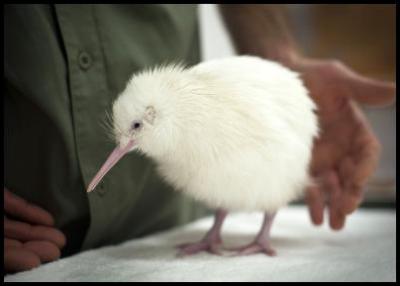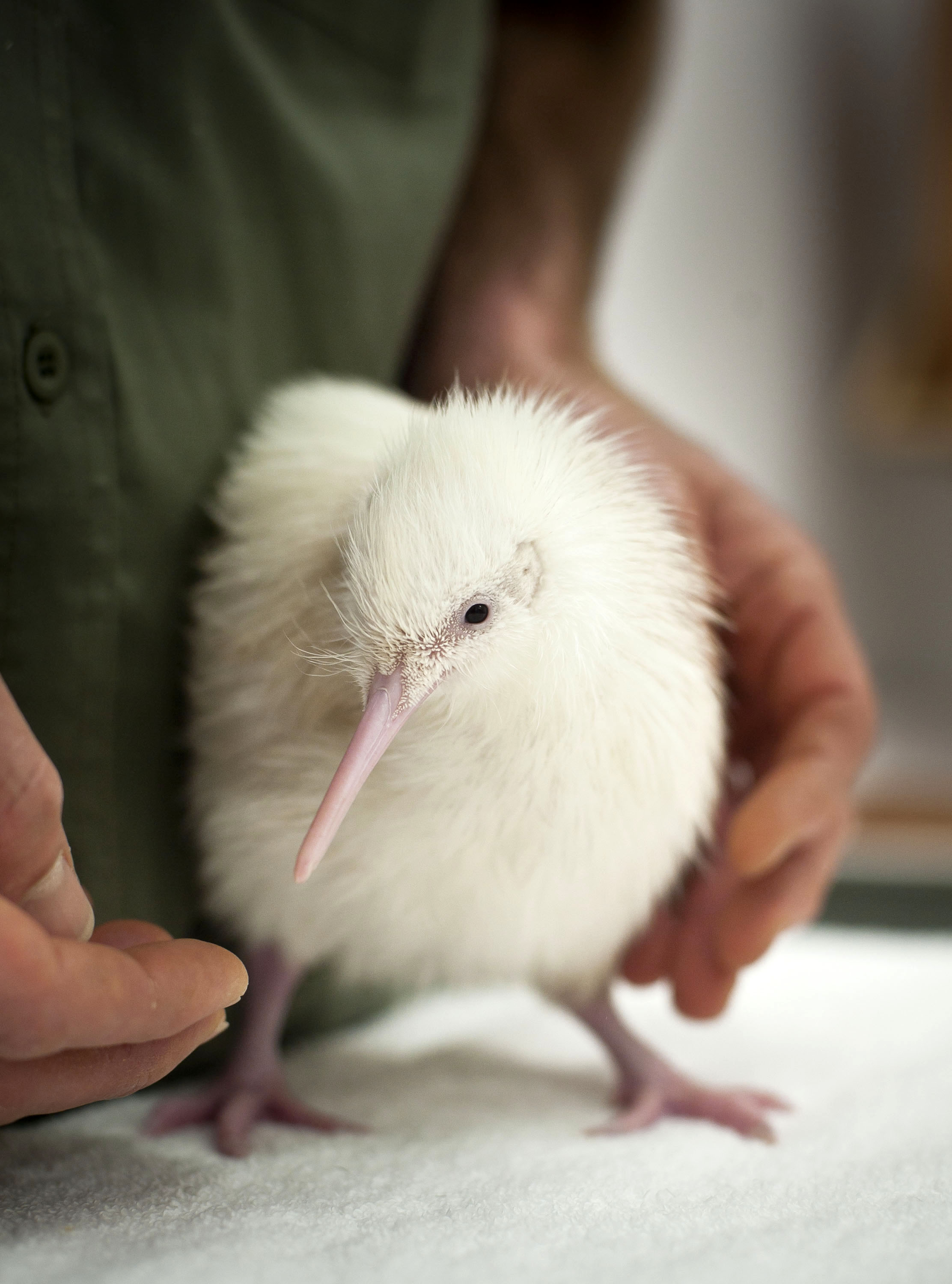Second White Kiwi Brings White Christmas To Pukaha
Mauriora - the second little white kiwi from Mike Heydon on Vimeo.
It’s a white Christmas at Pukaha Mount Bruce with the surprise hatching of a second rare white kiwi at the national wildlife centre.
The chick hatched last Sunday in the centre’s kiwi nursery, where Manukura, the world’s first white kiwi hatched in captivity arrived in May, creating global headlines.
“We were gob-smacked really,” centre manager Kathy Houkamau said. “While every kiwi is precious, to have a second white chick is a delightful gift, especially at this time of year. “We thought Christmas had come early in May when Manukura arrived but now it’s come twice.”
“The timing is wonderful for holidaymakers who can now see Manukura and brown kiwi in the nocturnal house, and view the new chick being hand-reared in the nursery from Boxing Day for approximately 10 days, all going well,” Ms Houkamau said.
A small number of North Island Brown Kiwi carry a recessive white gene which both the male and female must have to produce a white chick. Department of Conservation captive breeding ranger Darren Page said it was remarkable that two birds with the rare white gene had paired up in 940-hectare Pukaha forest to produce two white chicks over two seasons.
“Both white birds have the same father, who we have identified through his transmitter,” Mr Page said. “We can’t identify the mother but assume she is the same because of the rarity of the white gene.”
There is a one-in-four chance of such a pair producing a white chick. “The probability that the pair will breed again is quite high but we have no influence over the pairing and no way of knowing if they have produced more chicks together unless they’re white,” Mr Page said.

The parents of the two white chicks were among 30 kiwi transferred from Hauturu/Little Barrier Island in 2010 to boost the adult kiwi population at Pukaha. The white gene is thought to have found its way into the kiwi population on Little Barrier Island after a white kiwi was put on the island early last century. The island, north of Auckland, is generally off-limits to visitors.
Local Maori iwi Rangitane o Wairarapa has named the chick Mauriora, meaning ‘sustained life’. “Used as an exclamation or definition of something important, Mauriora is a powerful name,” Rangitane chief executive and Pukaha board member Jason Kerehi said. “This new kiwi is seen as an assurance that we are blessed with more than one special creature and there is potential for more.”
“In the Maori realm, all things have a ‘mauri’ or ‘essence’ but equally significant is that in order for mauri to flourish it must have a second element – the addition of a second white kiwi completes the mauri,” Mr Kerehi said.
The chick has brought surprise and delight to staff and board at Pukaha in what has been an extraordinary year. “It’s been phenomenal - not just because of the white chicks but the record kiwi breeding here over the past two seasons,” Mr Page said. “There was always a chance we could get another white kiwi but we didn’t really expect it. We hope it will further raise the profile of our work here and other kiwi recovery programmes.”
Eleven kiwi have hatched at the centre so far this season and with at least four months to go, more are expected. Of the two kiwi eggs currently incubating in the nursery one is from the same nest as Mauriora.
“We’ll have to wait and see what
that brings.” Mr Page said. “There is plenty of time
left this season for the kiwi pairs in the forest to produce
another whole set of fertile eggs.” Thirteen of the
fourteen kiwi successfully hatched last season at Pukaha
have been released into the 940-hectare native forest
there.
Pictures by
Mike
Heydon. Mauriora at 3
days
old.
Background:
- Hatched
on 1 May 2011 at Pukaha Mount Bruce, Manukura was the 13th
of 14 kiwi successfully hatched at the National Wildlife
Centre in the 2010/11 breeding season.
- Manukura was the first all-white chick to be
hatched in captivity. She was hand-reared in Pukaha’s new
kiwi nursery in exactly the same way as all
other chicks there. Kiwi are usually released into Pukaha’s 940-hectare native forest when they reach sub-adult weight (approx 1200g). - Manukura now resides in a nocturnal enclosure in the Pukaha kiwi house where visitors can see her daily (except Christmas Day).
- Named by local iwi Rangitane o Wairarapa, Manukura is not an albino but the rare progeny of kiwi that were transferred to Pukaha from Hauturu/Little Barrier Island in May 2010.
- Rangitane tribal elders saw the hatching of the
white chick
as a ‘tohu’ or ‘sign’ of new beginnings. They described Manukura as ‘a special gift’. - Meaning ‘of chiefly status’ the Maori name
‘Manukura’ joins the Rangitane people with Ngati
Manuhiri, the tribe from Little Barrier Island that helped
transfer 30 kiwi to Pukaha in 2010. ‘Kurahaupo’ was
a
Rangitane waka or canoe. ‘Manu’ means something of high rank and also a bird. ‘Kura’ means ‘precious’ and also ‘feather’. - Manukura made international headlines when she hatched in May. News of her arrival featured in major newspapers, on-line sites, on television, radio and in magazines around the world.
- She captured global attention again in
October when she swallowed two large stones and underwent
ground-breaking surgery after Wellington Zoo vets enlisted
the help of a surgeon to remove the stones with a
laser normally used to break up kidney stones in humans. - Manukura’s Facebook page http://www.facebook.com/#!/pages/Manukura-Little-White-Kiwi/218964361454747
follows her exploits and has a growing number of followers. - A Maori family living in Australia named their baby son Manukura, after following the story of the white kiwi online and in newspapers.
- The North Island Brown Kiwi species has a dominant brown gene.
- Both the male and female must carry the recessive white gene to produce a white chick.
- There is a
one-in-four chance of such a pair producing a white chick(options are BB = brown, Bw = brown, wB = brown, ww = white). - If two white birds bred, they would only produce white chicks.
- The white chicks are in every way normal and just like any other kiwi. The only characteristic that differentiates them from other kiwi is their colour.
- The white
feathers are not an absence of any colour pigmentation, they are pure white. - Nine out of ten kiwi chicks born in the wild die before they are six months old. Most are killed by stoats or cats, with others dying at the jaws and claws of other predators, or natural causes.
- Fewer than 5%
of kiwi make it to
adulthood. Adult kiwi are often killed by ferrets and dogs. - To grow a population of kiwi
requires only a survival rate of greater than 25%
among
chicks. The Pukaha breeding programme ensures a survival rate far exceeding this i.e. better than in the wild, by hatching and rearing chicks in captivity, for subsequent re-release to the wild forest as nearly-adult birds. - Kiwi are flightless, largely nocturnal birds. Related to the ostrich and emu, they live in pairs and mate for life, sometimes as long as 30 years. There are five different species, each with their own characteristics. All kiwi at Pukaha Mount Bruce are North Island Brown Kiwi.
- Some species of kiwi
– the Rowi and Tokoeka, are down to about 300 birds each. Little spotted kiwi have been extinct on the mainland for decades, but around 1500 are surviving in protected sanctuaries. - Overall there are now about 70,000 kiwi left in New Zealand. 200 years ago, millions of kiwi lived across NZ. By the turn of the 21st century, there were less than 100,000. At the present rate of decline, the number will be around 63,500 by 2018.
ENDS


 The Reserve Bank of New Zealand: RBNZ’s Five Year Funding Agreement Published
The Reserve Bank of New Zealand: RBNZ’s Five Year Funding Agreement Published Lodg: Veteran Founders Disrupting Sole-Trader Accounting in NZ
Lodg: Veteran Founders Disrupting Sole-Trader Accounting in NZ New Zealand Airports Association: Airports Welcome Tourism Marketing Turbocharge
New Zealand Airports Association: Airports Welcome Tourism Marketing Turbocharge Ipsos: New Zealanders Are Still Finding It Tough Financially; Little Reprieve Expected In The Next 12 Months
Ipsos: New Zealanders Are Still Finding It Tough Financially; Little Reprieve Expected In The Next 12 Months NZ Telecommunications Forum - TCF: Telecommunications Forum Warns Retailers About 3G Shutdown
NZ Telecommunications Forum - TCF: Telecommunications Forum Warns Retailers About 3G Shutdown PSA: Worker Involvement Critical In Developing AI For The Good Of Aotearoa
PSA: Worker Involvement Critical In Developing AI For The Good Of Aotearoa



